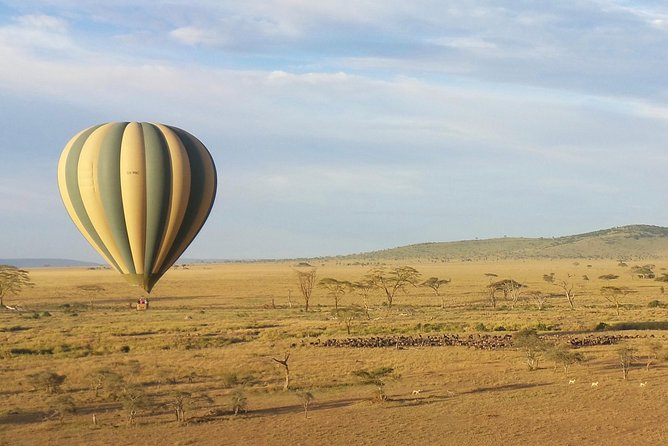Sunrise view, plains and wildlife from a perspective many never experience
What’s included
- Hot air balloon flight over Serengeti National Park as day breaks
- Relax with included breakfast
- Champagne
- Most Serengeti Balloon Safaris last for about an hour. A different course is taken for each flight, depending on the conditions and wind direction, meaning the landing point for each flight is largely unknown beforehand.
Nothing quite illuminates unparalleled views from the clouds of the untouched wilderness and seemingly endless plains, or the experience of floating through the sky above thousands of wildebeests, zebras, antelopes and predators.
Passenger requirements for a Serengeti Balloon Safari?
1: All passengers must be able to use their arms to hold onto rope handles during take-off and landing. They must be able to bend their knees and be mobile enough to climb in and out of the basket.
2: Please note: Passengers potentially weighing more than 265lbs, 19 stone or 120kg may be charged for two people.
3: Hot air balloon trips are not suitable for pregnant people and people with heart problems.

Combo Serengeti safaris
Guests are picked up from their lodges inside Serengeti very early in the morning. be prepared to be picked up around 4.00 am – 5:30 AM
It is recommended that passengers bring a hat with them for protection not only from the sun, but also from the intense heat of the burners. Although the burner creates heat, the temperature is often cool in the morning, so a jacket is recommended. Long-sleeved tops and long trousers are necessary, and cameras and binoculars are pretty essential
The dry season (June to October) is the ideal time for a hot balloon safari in the Serengeti. However you can do hot air balloon all year round
- April, May, November: Central Serengeti
- June: Western Serengeti
- July, August, September, October: Northern Serengeti
- December: Ndutu
Every precaution is taken to ensure that the pilot and passengers are not only safe, but able to enjoy a thrilling experience.
The balloons are flown by meticulous pilots who run through rigorous pre-flight safety checks. The pilots will also analyse the conditions and wind speed before deciding to take off or not.
Registered balloon safari companies are fully licensed and annually inspected by the Tanzania Civil Aviation Authority. It is also mandatory for passengers to be strapped in with a passenger seat belt.
Soaring high above the wildebeests down below can be a nerve-wracking experience for those with a fear of heights. Passengers who have undertaken a hot air balloon ride, however, can attest to the fact that in the end, their fear of falling was unfounded.
Mesmerizing View Of Sunrise
Sunrise on the Serengeti is an epic view that you will never forget! Early morning is the best time for wildlife viewing in Serengeti National Park.
The cool dawn hour is the right time to watch the wildlife. It is the time when animals are most active.
Witnessing The Great Migration
If you want to see the Great Wildebeest Migration, the Serengeti Balloon safari is the best option. Viewing the Great Migration may feel lost in the sea of wildebeest! Opting for a hot air balloon ride can help you enjoy the big picture of the wildebeest migration. You get a bird’s eye view of the thrilling migration.
Adventurous Off-Road Experience
There are designated trails for safari via roads to preserve Tanzania’s Serengeti National Park. Safari vehicles need to follow and stay on the designated trails. It helps protect the wildlife and landscape of the Serengeti National Park.
A hot air balloon over Serengeti National Park proves to be an interesting and exciting off-road safari experience. It provides you with limitless opportunities to explore the National Park beyond the designated trails.
Enjoy Champagne Bush Breakfast
After a hot air balloon ride, the crew and passengers celebrate by popping a few corks and enjoying a hearty breakfast in the bush in the middle of the Serengeti.
The magic of Serengeti National Park is not easy to describe in words. Not only seeing, but also hearing the buzz of millions of wildebeest so thick in the air that it vibrates through your entire body is something you will try to describe to friends and family, before realising it’s impossible. Vistas of honey-lit plains at sunset so beautiful, it’s worth the trip just to witness this. The genuine smiles of the Maasai people, giving you an immediate warming glow inside. Or just the feeling of constantly being amongst thousands of animals – it doesn’t matter what season of the migration you visit the Serengeti National Park, it’s magical all year round.
In the late 1800s and early 1900s, explorers and missionaries described the Serengeti plains and the massive numbers of animals found there. Only minor details are all that were reported before explorations in the late 1920s and early 1930s supply the first references to the great wildebeest migrations, and the first photographs of the region.
An area of 2,286 square kilometers was established in 1930 as a game reserve in what is now southern and eastern Serengeti. They allowed sport hunting activities until 1937, after which it stopped all hunting activities. In 1940 Protected Area Status was conferred to the area and the National Park itself was established in 1951, then covering southern Serengeti and the Ngorongoro highlands. They based the park headquarters on the rim of Ngorongoro crater.
So, the original Serengeti National Park, as it was gazetted in 1951, also included what now is the Ngorongoro Conservation Area (NCA). In 1959, the Ngorongoro Conservation Area was split off from the Serengeti National Park and they extended the boundaries of the park to the Kenya border. The key reason for splitting off the Ngorongoro area was that local Maasai residents realized that they were threatened with eviction and consequently not allow to graze their cattle within the national park boundaries. To counter this from happening, protests were staged. A compromise was reached wherein the Ngorongoro Crater Area was split off from the national park: the Maasai may live and graze their cattle in the Ngorongoro Crater area but not within Serengeti National Park boundaries.
In 1961 the Masai Mara National Reserve in Kenya was established and in 1965 the Lamai Wedge between the Mara River and Kenya border was added to Serengeti National Park, thus creating a permanent corridor allowing the wildebeests to migrate from the Serengeti plains in the south to the Loita Plains in the north. The Maswa Game Reserve was established in 1962 and a small area north of The Grumeti River in the western corridor was added in 1967.
The Serengeti National Park was among the first places to be proposed as a World Heritage Site by UNESCO at 1972 Stockholm conference. It was formally established in 1981.

